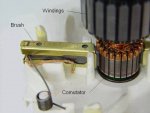Chainbreaker
Well-known member
- 1,832
- 2,112
- 113
- Location
- Oregon
Hmm, I knew there had to be a connection behind high quality German beer & high quality German cars!
Steel Soldiers now has a few new forums, read more about it at: New Munitions Forums!

This should be like the starter pictured in the -24P, Figure 63, Item #. None PDF readier page number 251. Figure 62 is a slightly different version, and was replaced by the item 63 model.
They may still have repair parts. Kris, if the price of fixing it is higher then the one in Flebay, think about it.
They may still have repair parts. Kris, if the price of fixing it is higher then the one in Flebay, think about it.
Guy,
Peter tested the Frequency Transducer and determined that it was OK.
But the gages on the control panel are varying.
59 to 60 hz
and 208 t0 210 on the volts
Is this normal to you.
I don't know if this is good or bad.
Kris

Update on starter:
There was a lot of things wrong with it which I cant repeat because I don't understand the slang.
A commentator needs to be purchased.
So I wont have it until sometime next week.
It should be close to brand new when he is finished.
When I get it back I will ask him what he thinks caused the need of repair.
Kris
It depends on what you are powering. For your house and needs, 1 hertz is no big thing. For a 25 million dollar missile system, yes, it's a big thing. Two volts, the same.Guy,
Peter tested the Frequency Transducer and determined that it was OK.
But the gages on the control panel are varying.
59 to 60 hz
and 208 t0 210 on the volts
Is this normal to you.
I don't know if this is good or bad.
Kris
Like I posted earlier. Dead short to ground. That's why the M4 DC meter went deep into the red. Modern brushes have a spring, with a non conductor end piece, that pushes the brush away from the commutator when it gets too worn. No contact between the brush and commutator, no start. But saves the commutator from being destroyed.Kris, I hate being a smart ass, bu it’s
A commutator is a rotary electrical switch in certain types of electric motors and electrical generators that periodically reverses the current direction between the rotor and the external circuit. ... In a motor the commutator applies electric current to the windings.
cause: one trillion starts in 40 years so the brushes wore down and grinding down the commutator with the springs
because of lack of care of the previous owner.....
View attachment 779084
Update:
I finally ran Peters request to check hz and volts at L1 and L0.
I was witnessing on the control panel the hz and volts varying.
hz was varying from 59 to 60 hz. The volts varying about 2 volts at 208 setting.
So peter instructed me and patiently helped me set my DMM to hz.
Started the gen and compared the control panel gages to the DMM with no load on the gen
Panel switch was in the L1-L2 position
Results:
Panel was varying 59 to 60 hz entire time the gen was running
DMM was varying approx. -.5 hz starting at 59.5 hz then during 5 mins of running climbed to 60 hz varying only -.05 hz
The readings were the same with the breaker closed and open.
The gen doors were open and the slight breeze seemed the effect the hz. approx. .05 hz
After this test gen was shut down.
Next was to test the volts against the panel and DMM.
Set the DDM to VAC
Started gen and compared volts
Breaker open
Panel: 208 varying +2 volts
DMM : 15.9 volts
Breaker closed
Panel: 208 varying +2 volts
DMM: 119.7 solid no variance
Peter thinks the Frequency regulator in the control panel needs looked at. (Peter correct me if I misspoke)
So I told him I would un install it and have him test and repair.
Also because the volts was not varying he said the A11 was operating to spec
Kris
I won't say it's more accurate. But maybe more sensitive. You can see the meter needle move. The new DMM may be better then what I used years ago. Don't know.Guy,
we did this already with DMM on TB1
The gauges have response time of 350ms to 700ms
hard to believe that a 40 year old Analog Gauge / Meter is more accurate then a DMM
This is the reason why I had Kris sent the transducer to me so I could verify the correct operation - The DC Voltage output does not drift at all
We get it, advertisements are annoying!
Sure, ad-blocking software does a great job at blocking ads, but it also blocks useful features of our website like our supporting vendors. Their ads help keep Steel Soldiers going. Please consider disabling your ad blockers for the site. Thanks!

